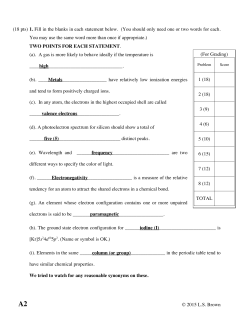
Chem 152 Midterm 2 (Sample)
Chem 152 Midterm 2 (Sample)
Section:______________
Name:_________________
Note that equations that you will be provided with appear at the end of the exam.
Page 1
1. Multiple Choice (4 pts. each):
a. For an electrochemical cell to be galvanic, what must be true:
A. Ecell < 0
B. ΔG < 0
C. K=1
D. n = 2
b. The potential of interaction between an electron and which of the following
species will be greatest in magnitude for the following:
A. H
B. He+
C. Li+2
D. He
c. The electron configuration 1s22s22p63s23p64s23d5 corresponds to:
A: Tc
B: Mn
C: Fe
D: Cr
d. Which element has the electronic structure [Ar]4s23d6:
A: V
B: Cr
C: Fe
D: Ru
e. The workfunction of Nb is 6.67 x 10-19 J. This corresponds to which of the
following wavelengths:
A. 459 nm
B. 287 nm
C. 298 nm
Page 2
D.
320 nm
Multiple choice (cont.)
f. No currently known element contains electrons in “g orbitals,” but we may
find such elements one day. How many electrons can be incorporated into a
set of g orbitals:
A: 10
B: 14
C: 18
D: 20
g. Which of the following is not an allowed set of quantum numbers for the H
atom (given in the form {n, l, ml}):
A: {3, 1, 1}
B: {2, 0, 0}
C: {0, 0, 0}
D: {1, 0, 0}
h. What is the ionization energy for the H atom?
A: 5.3x106 J/mol
C: 2.6x106 J/mol
B: 1.3x106 J/mol
D: 2.1x106 J/mol
j. If n = 3 and l = 2, how many ml levels are there:
A: 1
B: 3
C: 5
D: 10
k. Sodium losing an electron is a ____________ process, and fluorine losing an
electron is a ____________ process.
A:
B:
C:
D:
endothermic, exothermic
endothermic, endothermic
exothermic, endothermic
exothermic, exothermic
Page 3
Section II: Long-Answer/Numerical Questions
2 (20 pts.) Lewis Dot Structures. Write the Lewis dot structures for the following
compounds. Include all structural isomers, resonance structures, and formal
charges for each structure. Underline the one you believe is the most-reasonable
structure. Finally, using VESPR describe the 3D geometry of your mostreasonable structure. An example is provided below:
Ex: O3
geometry __________________.
a) BrO2
-
geometry __________________.
b) SF4
geometry __________________.
c) ONF
geometry __________________.
Page 4
3 (10 pts.) What wavelength of light corresponds to electron relaxation from n = 4
to n = 1 in Li+2?
Page 5
4. A proposed fuel cell involves the following reaction:
1
CO(g) + O2 (g) → CO2 (g)
2
Given the standard thermodynamic data below, determine the half-cell
potential for the oxidation of CO(g) in aqueous media.
€
Compound
CO(g)
CO2(g)
O2(g)
ΔH°f (kJ/mol)
-110.52
-393.51
0 (stable elemental form)
Page 6
S° (J/mol.K)
197.56
213.63
205.03
More room for problem 4
Page 7
5a. Consider the following electrochemical cell:
Cr(s) Cr +3 (aq) NO3− (aq) NO(g) (with a Pt electrode)
Write a balanced reaction for the above reaction occurring in acidic solution
and determine the cell potential.
Page 8
5b. A precipitating reagent is added to the anode side of the electrochemical cell
and the cell potential increases to 1.9 V. Determine the concentration of
the original ionic anode species after the addition of the precipitating
reagent.
Page 9
Standard Electrode (Half-Cell) Potentials (298 K)
Skeletal Half Reaction (as Reduction)*
E° (V)
Co+3 (aq)/Co+2 (aq)
Au+3(aq)/Au(s)
O2(g)/H2O(l)
Br2 (l)/ 2Br- (aq)
NO3- (aq)/NO (g)
NO3- (aq)/N2O4 (g)
Ag+ (ag)/Ag (s)
O2(g)/OH-(aq)
Cu+2 (aq)/Cu (s)
2H+ (aq)/H2 (g)
Sn+2 (aq)/Sn (s)
Cd+2 (aq)/Cd (s)
Fe+2 (aq)/Fe (s)
Cr+3 (aq)/Cr (s)
Zn+2 (aq)/Zn (s)
Mg+2 (aq)/Mg (s)
Na+ (aq)/Na (s)
+1.82
+1.50
+1.23
+1.07
+0.96
+0.83
+0.80
+0.40
+0.34
0.00
-0.14
-0.40
-0.44
-0.74
-0.76
-1.18
-2.71
*All reactions are written as reductions. Water/H+/OH-/e- needed to create a
balanced half-cell reaction are suppressed.
Page 10
Useful Information
Constants: h = 6.626x10-34 J.s
c = 3 x 108 m/s
F = 96,485 C/mol ee- charge = 1.6 x 10-19 C
e- mass = 9.1 x 10-31 kg
R = 8.314 J/mol.K = 0.0821 l.atm/mol.K
1 nm = 10-9 m
E = −2.178x10
−18
Z2
J 2
n
n 2h 2
E=
8mL2
o
E cell = E cell
−
o
ΔG° = −nFE cell
= −RT lnK
€
ΔG = ΔG° + RT ln(Q)
€
€
c
€
→
€
aA + bB ←
cC + dD
€
E = hν =
0.0591V
log(Q)
n
d
[C ] [ D]
K=
a
b
A
B
[ ][ ]
1
meν 2 = hν photon − Φ
2
€
€
−(Ze)(e)
V (r) =
r
€
Δx • Δp =
h
4π
For H-atom like wavefunctions (l = “el”, not one):
€
n = 1, 2, …., l = (n-1), (n-2), …. 0, ml = -l……0……l, ms = ± 1/2
€
Page 11
hc
λ
© Copyright 2025





















